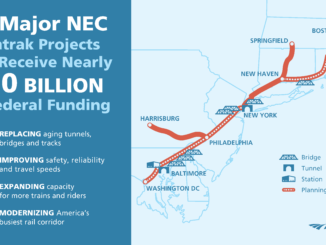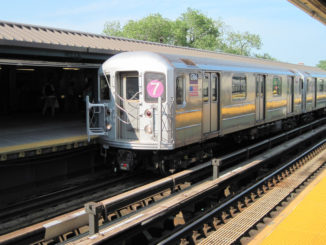NEW YORK — Citing record ridership growth, the Staten Island Railway (SIR) said it was expanding its rush hour express train service.
The expansion, which began Nov. 14, will provide additional service to commuters who rely on SIR express and local service to and from the Staten Island Ferry while also providing an alternative to construction-related delays on area highways, officials said.
“NYC Transit has devoted considerable time and effort into crafting schedules and in developing quality service improvements that our SIR riders would find attractive,” said MTA Executive Director & CEO Elliot G. Sander. “That hard work is paying off with ridership up considerably since 2005, reaffirming the MTA’s commitment to improving transportation services for Staten Island commuters”
The additional rush hour service will be phased in, with evening service the first to be expanded on Nov. 14, officials said. Under the new schedule, the first evening express train will continue to connect with the boat departing Whitehall Terminal at 4:00 p.m., and now the last scheduled express will connect with the boat departing Whitehall Terminal at 7:20 p.m.
Five additional express trains will connect with boats departing from the Whitehall Terminal at 6:15, 6:30, 6:45, 7:00 and 7:20 p.m. In all, the evening express schedule will be expanded by an hour and 20 minutes.
“This is the second substantive change to the SIR schedule since 2005 when the entire schedule was overhauled for the first time in several decades,” said MTA NYC Transit President Howard H. Roberts, Jr. “Our railway customers have consistently told us they would ride more if we expanded express service. We did just that last year and, true to their word, our riders responded favorably. We expect they will do so again with the changes we’re making now.”
In 2006, the number of SIR riders passing through the St. George Ferry Terminal daily grew 9 percent, from 12,647 to 13,781. That ridership growth has continued this year, with average weekday ridership at St. George up 7.2 percent to 14,287 through September.
On Dec. 5, morning rush hour express service will be expanded with the first express train to connect with the boat departing St. George Terminal at 7:00 a.m., instead of the current 7:15 a.m. boat. Express service will continue to connect with ferry boats departing St. George at 7:15, 7:30, 7:45, 8:00, 8:15, and 8:30 a.m., with additional express trains now connecting with the 8:45 and 9:00 a.m. ferry departing St. George Terminal.
In all, the span of express service will be expanded by 45 minutes with three additional express trains added to the morning schedule.
Express service to Tottenville will also be introduced in the morning rush hour with five express trips connecting with boats departing Whitehall Terminal between 6:30 and 7:30 a.m. Additional local service is being added to the morning schedule as well, with five trains stopping at Huguenot, Annadale and Eltingville Stations. Those trains will connect with boats departing St. George Terminal at 7:00, 7:15, 7:30 and 8:00 a.m.
“These new service improvements, in combination with many other enhancements implemented by the railway over the last several years, provide a convenient and attractive alternative to construction-related delays on the highways,” said John G. Gaul, SIR Chief Operating Officer.
New schedules and customer information will be available to evening riders beginning Nov. 12 and for morning riders on Dec. 3.
The increase in SIR express service would not be possible without the new, state-of-the-art Cab Signaling System along with a 21st Century Control Center at St. George which went into operation in June 2005. The new technology installations, valued at $100 million and funded by the MTA Capital Program, enhance safety while offering operating flexibility that was not available with the old system.
Prior to the new installation, the 22-station, 14-mile railway operated with signal technology created in the early 1900’s and lacked many of the features of modern systems. The advantages of the new signal system include continuous speed enforcement, improved signal visibility, and more reliable service.
Central monitoring at the new Control Center provides supervision with access to real time information so that they can react to problems more quickly, with the ability to change switch positions remotely, as all main line switches are now interlocked.
— Special to Railfanning.org




